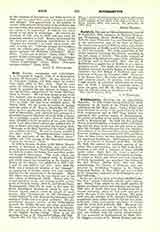

Rock, DANIEL, antiquarian and ecclesiologist, b. at Liverpool, August 31, 1799; d. at Kensington, London, November 28, 1871. He was educated at St. Edmund’s College, Old Hall, where he studied from April, 1813, to December, 1818. There he came under the influence of the Rev. Louis Havard from whom he acquired his first interest in liturgy, and was the intimate companion of the future historian, Mark A. Tierney. He was then chosen as one of the first students sent to reopen the English College at Rome, where he remained till he took the degree of D.D. in 1825. He had been ordained priest, March 13, 1824. On his return to London he became assistant priest at St. Mary’s, Moorfields, till 1827, when he was appointed domestic chaplain to John, Earl of Shrewsbury, with whom he had contracted a friendship based on similarity of tastes while at Rome. He accordingly resided at Alton Towers, Staffordshire, till 1840, with the exception of two years during which Lord Shrewsbury’s generosity enabled him to stay at Rome collecting materials for his great work, “Hierurgia or the Holy Sacrifice of the Mass“, which was published in 1833. He had previously published two short works: “Transubstantiation vindicated from the strictures of the Rev. Maurice Jones” (1830), and “The Liturgy of the Mass and Common Vespers for Sundays” (1832).
In 1840 he became chaplain to Sir Robert Throckmorton of Buckland in Berkshire, and while there wrote his greatest book, “The Church of Our Fathers”, in which he studies the Sarum Rite and other medieval liturgical observances. This work, which has profoundly influenced liturgical study in England and which caused his recognition as the leading authority on the subject, was published in 1849 (vols. I and II) and 1853-4 (vol. III). After 1840 Dr. Rock was a prominent member of the “Adelphi”, an association of London priests who were working together for the restoration of the hierarchy. When this object was achieved, he was elected one of the first canons of Southwark (1852). Shortly after, he ceased parochial work, and having resided successively at Newick, Surrey (1854-7), and Brook Green, Hammersmith (1857-64), he went to live near the South Kensington Museum in which he took the keenest interest and to which he proved of much service. His “Introduction to the Catalogue of Textile Fabrics” in that Museum has been separately reprinted (1876) and is of great authority. He also contributed frequent articles to the Archaeological Journal, the Dublin Review, and other periodicals. For many years before his death he held the honorable position of President of the Old Brotherhood of the English Secular Clergy. There is an oil painting of him at St. Edmund’s College, Old Hall.
EDWIN BURTON

